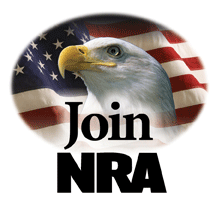(Originally written 08-01-09)
A little background on the BCM 03 MSF Chest Harness.
Let me start off by saying I didn't invent the 2 piece chest rig with yoke and hydro carrier. The original design goes back to the late 70's / early 80's. The South African M83 battle vest is probably the original 2 piece chest rig that featured a yoke and hydration carrier.
I have been using 2 piece chest rigs since 2000 for both work and training classes. My first 2 piece chest rig was a S.O.E. chest rig with hydro carrier that I wore over my body armor for SWAT. The picture in my avatar (pic taken in Feb of 2002) shows me wearing the 2 piece chest rig over my body armor. This was before body armor carriers covered in PALS webbing was readily available on the civilian / law enforcement market.
Since 2000 I have used numerous different 2 piece chest rigs (South African M83 Battle Vest, Tactical Tailor 2 piece MAV with X-Harness and hydro carrier, several different S.O.E. split front chest rigs with hydro carriers, SO Tech Hellcats, TAG Split Front Chest Rigs, Eagle Ind. Load Bearing Air Rescue Vest and Enhanced Load Bearing Vest, London Bridge Trading, Arktis and several other 2 piece chest rig designs). I have spent a small fortune on tactical gear over the years.
The main complaint I had with all of the designs I used over the years was most 2 piece chest rigs were either too large and/or too cumbersome for my needs. Most of the designs listed above were geared toward military users. The designs were overkill for what I wanted and needed in a chest rig. At 5'06" / 150 lbs some of these chest rigs were too large for me, and others would fit but I had the adjustment straps cinched down as tight they would go.
My original chest rig design dates back to around 2004. It was based on my needs for work and from my experiences with several other chest rig designs. There was a void in the market. I wanted a low profile 2 piece chest rig with yoke and hydro carrier that carried the gear that I needed without a lot of stuff that I didn't need. I'm a Police Detective and I take a lot of training classes. I don't need an MBITR pouch or grenade pouches or smoke pouches or the ability to carry 8 to 14 carbine mags, etc. There wasn't much available in the way of low profile 2 piece chest rigs, and attaching a yoke and hydro carrier to a 1 piece chest rig is a chore to get into or out of.
In 2004/2005 I posted the concept for my design on another forum (unpadded yoke, detachable hydro carrier, each side of the two piece chest rig would be 6 PALS channels (12 total PALS channels), capable of carrying 4 to 6 carbine magazines). After I posted the design concept and features I was contacted by a gear company who wanted to put that chest rig design (and a plate carrier design I had) into production. That company never followed through and the chest rig and plate carrier was never made.
Diz and I have been friends and have shared info on-line for approximately the last 8 years. Diz is a great dude and produces some of the best custom gear I have seen. Diz and I had several on-line conversations about different gear set ups over the years. It was due to this background that I went to Diz to build my custom chest rigs in early 2008 when he started building custom gear full time. Diz built two chest rigs based on my specs, a tan (for training) chest rig that carried 6 mags, and a black (for work) chest rig that looked almost identical but carried 4 mags, a radio, and a pistol. Diz named those chest rig the USMC03 chest rig. Unfortunately Diz got out of the gear building business and moved onto other things.
I like the two piece chest rig design because they are comfortable, versatile, quick and easy to don and doff.
I wanted a two piece chest rig design that was:
-Modular -Versatile -Light Weight -Low Profile -Well balanced -Quick and easy to put on -A design that would not interfere with the gear that I would be wearing no matter if I was wearing a suit, Patrol uniform, plain clothes, or SWAT uniform.
I currently work as a plain clothes Detective and I'm also assigned to the SWAT team. Due to my current assignment I don't wear a concealable vest during my entire shift, like I did when I worked Uniformed Patrol. I wear body armor on an “as needed” basis. For most SWAT missions I wear a Eagle Industries Law Enforcement CIRAS. I have found over the last several years that there was a void between my concealable body armor and my SWAT armor. Concealable body armor is low profile, but lacks the ability to carry any kind of support gear (ie. rifle magazines, pepper spray, radio, etc.). The LE CIRAS is a great armor carrier that can support mission essential gear, but it's not low profile and takes longer to don.
A few examples of when a low profile / quick to don chest rig would be beneficial for carrying mission essential gear:
-When my unit is serving small knock and announce warrants, undercover high risk arrests / take downs, and other situations where we are trying to keep a low profile but long guns are needed.
-SWAT is assisting narcotics or another unit with a mission. Due to the nature of buy / bust operations, high risk take downs, and similar type missions, we are often in undercover cars and wearing plain clothes. In situations like these, I need gear that will fit under a button down shirt and can carry carbine magazines, pepper spray, radio, etc.
-Working in the office and an "in progress" call goes out (ie. bank robbery in progress, shooting in progress, etc.) I need to grab my carbine, gear, and run out the door (in a situation like this I have found the CIRAS took to long to don and interfered with gear that I was already wearing).
-When wearing a patrol uniform, I wanted something that I could throw on over my uniform that wouldn't interfere with the gear I was wearing, wasn't too large or bulky, and I would be readily accessible when I had to deploy the carbine.
In early 2009 I contacted Paul Buffoni at Bravo Company USA and discussed with him my chest rig design and asked if he would be interested in bringing it to market. Paul was very supportive and told me that he would be interested in taking part in the project.
I then went to Stephen Hilliard at Blue Force Gear to see if he would help me build the chest rig. Stephen is a master at his craft and an all around good guy.
The end result is the BCM / 03 Design Group - BCM 03 MSF Chest Harness
Specs:
-All materials and construction are made in the USA.
-Chest rig is constructed of 500 denier Cordura fabric to reduce weight without greatly sacrificing durability or performance.
-Solid colors are solution dyed for low infrared (IR) reflectivity and flat finish.
-Camouflage patterns are printed with low infrared (IR) inks.
-All fabrics meet or exceed Mil-C 43734, Class 3/4.
-Webbing is solution dyed Cordura for durability, low infrared (IR) reflectivity, and flat finish.
-All camouflage chest rigs use pattern matched webbing.
-Thread is A&E Tex70 nylon thread.
-Mesh material on inside of yoke / shoulder straps is moisture wicking and anti-microbial. The mesh material is treated with a flash/flame resistant solution that is rated for the life of the garment (will not wash or wear out).
-All plastic hardware is ITW Ghillie-Tex for durability and low infrared (IR) reflectivity.
Features:
The body of the BCM 03 MSF Chest Harness holds a total of four M4 magazines (four single cell M4 pouches). The magazine pouches are flanked by a panel of two channels of MOLLE webbing. The yoke is unpadded and lined with mesh material. The hydration carrier is removable and adjustable. The hydration carrier (with use of a water bladder) helps counter balance the weight of the loaded magazines and other gear on the front of the chest harness.
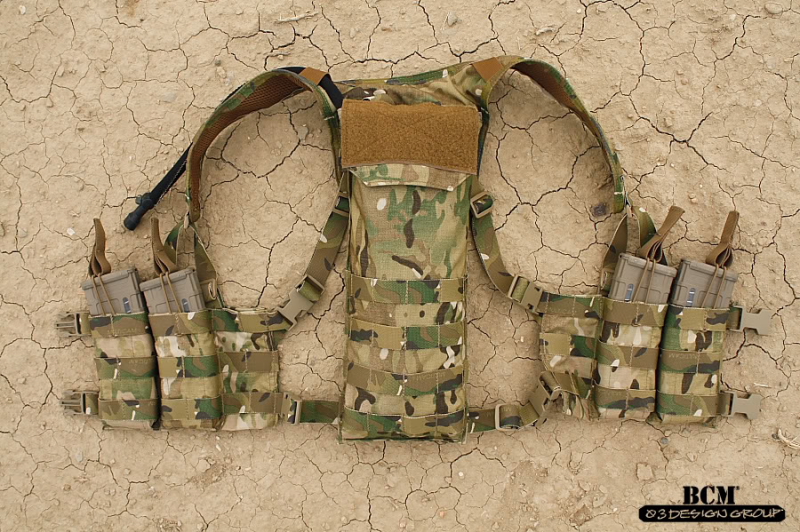
BCM 03 MSF with hydration carrier removed:
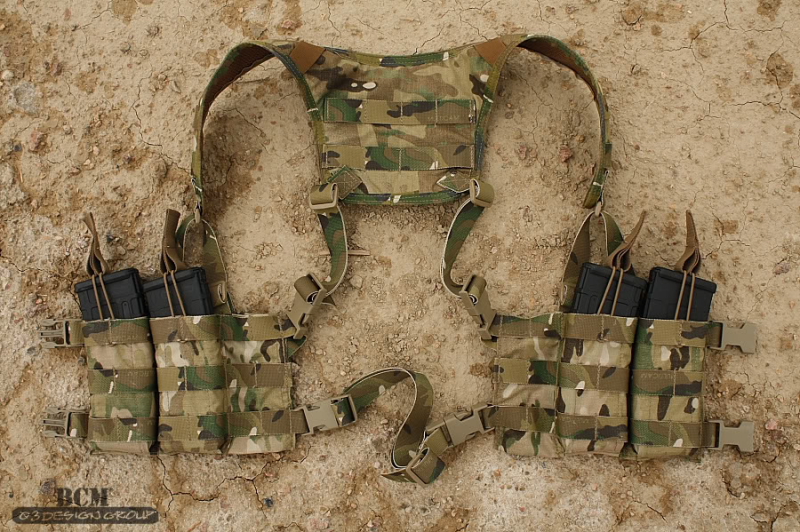
Right side of the BCM 03 MSF Chest Harness: Two single cell M4 magazine pouches flanked by a panel containing two channels of MOLLE webbing. There are a total of 6 channels and 3 rows of MOLLE webbing on each side of the chest harness. Magazines are secured by bungee cord and pull tab:
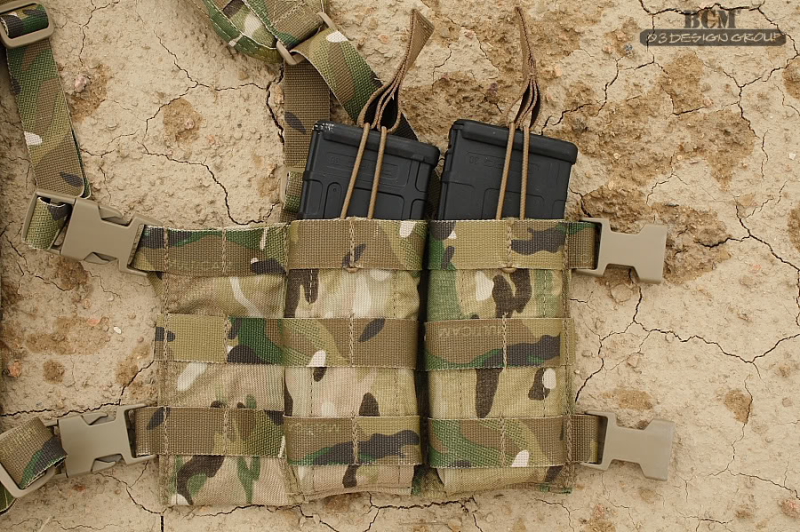
The Adjustable Load-Bearing Strap System was designed by Stephen Hilliard at Blue Force Gear. The Adjustable Load-Bearing Strap System, or A-Strap for short, uses a single piece of 1" Cordura webbing attached at 3 different points of contact to better distribute the weight of the load. It also allows some articulation where the A-Strap attaches to the shoulder harness which allows for greater freedom of movement and flexibility of the chest harness:
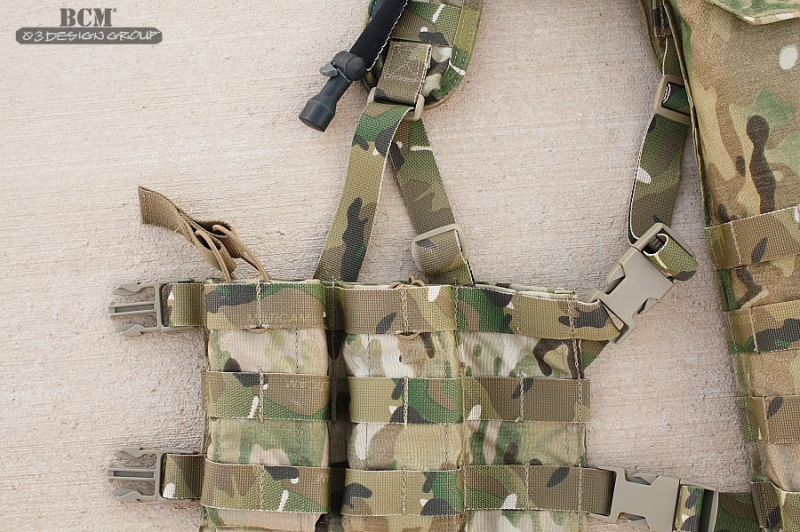
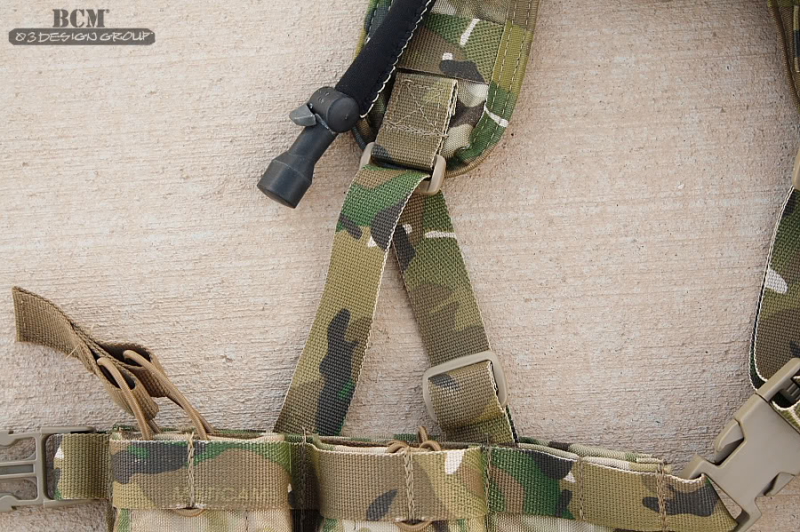
Internal map pocket. When wearing the BCM 03 MSF Chest Harness you don't notice that the chest harness contains a map pocket. The pocket is easy to access and can be used to store maps, warrant service paperwork, floor plans of schools or other large buildings (active shooter), pens, foam ear plugs, or any other small items:
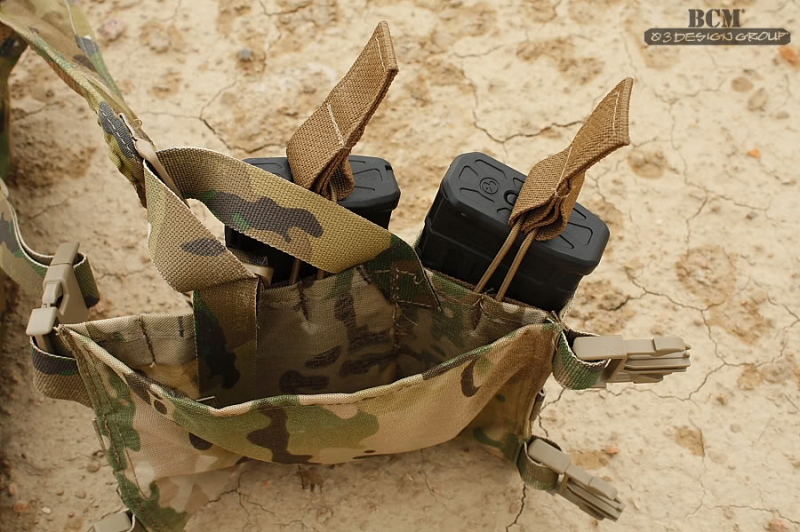
Front of the yoke shoulder strap. Note the two 1" strips of webbing. These strips can be used to route communication wiring, hydration tubes, or attach a badge or radio shoulder mic:
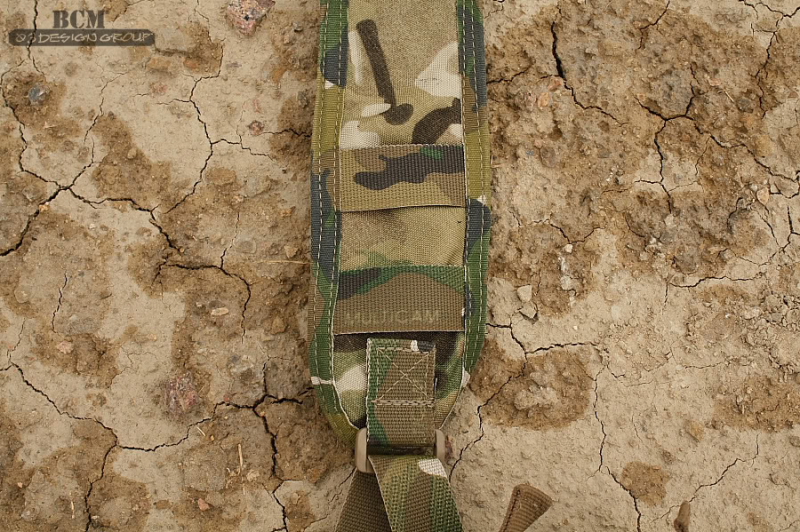
Underside of the unpadded yoke shoulder strap. The mesh material is moisture wicking, anti-microbial, and treated with a flash / flame resistant solution that is rated for the life of the garment (will not wash or wear out).
Most other designs that I have used incorporate a padded yoke or shoulder straps. The unpadded yoke sits better on the shoulders, doesn't chaff as much as many padded yokes, works better when wearing a backpack over the yoke, doesn't add excess bulk when being worn over outer garment armor vests, and doesn't print when being worn under a button down shirt or light jacket:
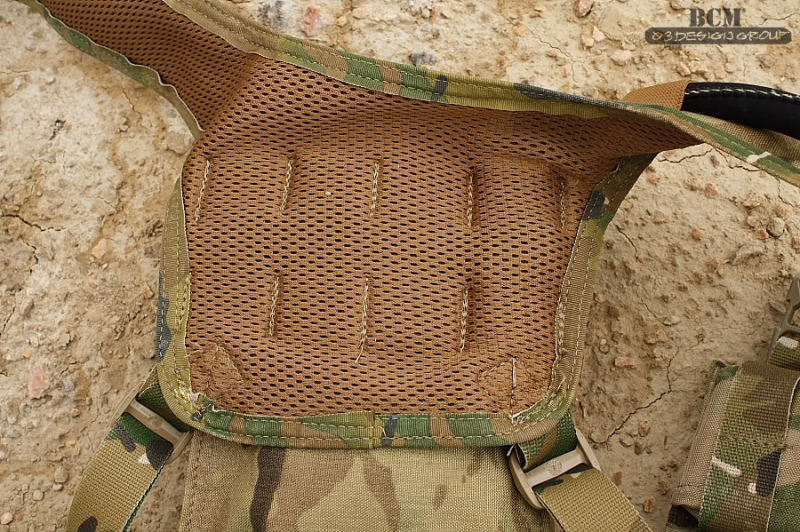
Bottom of the hydration carrier. Two different channels for the bottom back strap to pass through for maximum range of adjustability of the yoke and hydration carrier:
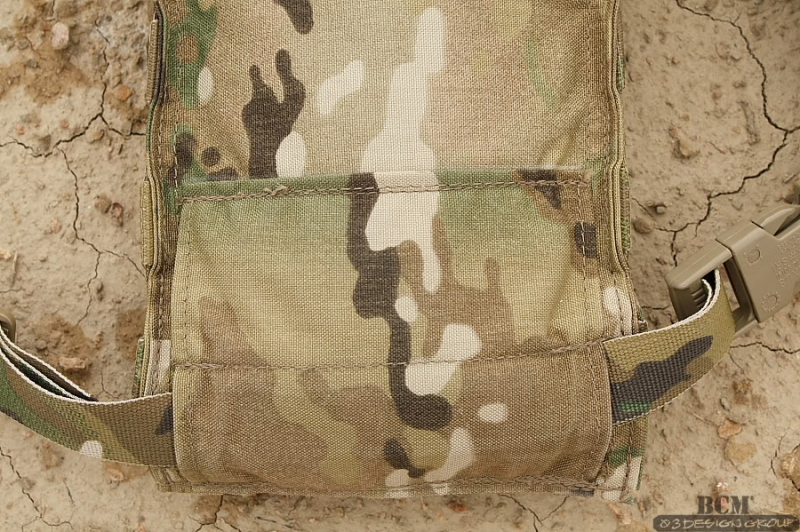
Inside the top of the hydration carrier. Use a piece of 550 cord, run the 550 cord through the nylon loop at the top of the hydration carrier and through anything you can attach it to at the top of your hydration bladder. This will keep the hydration bladder from collapsing at the bottom of the hydration pouch:
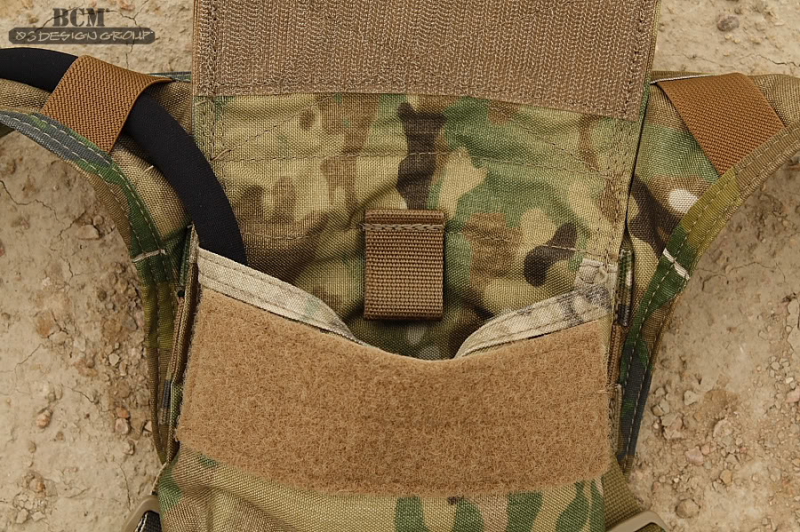
Detective:
75% of my work week is done in a suit and tie (shown here). The other 25% I wear plain clothes:
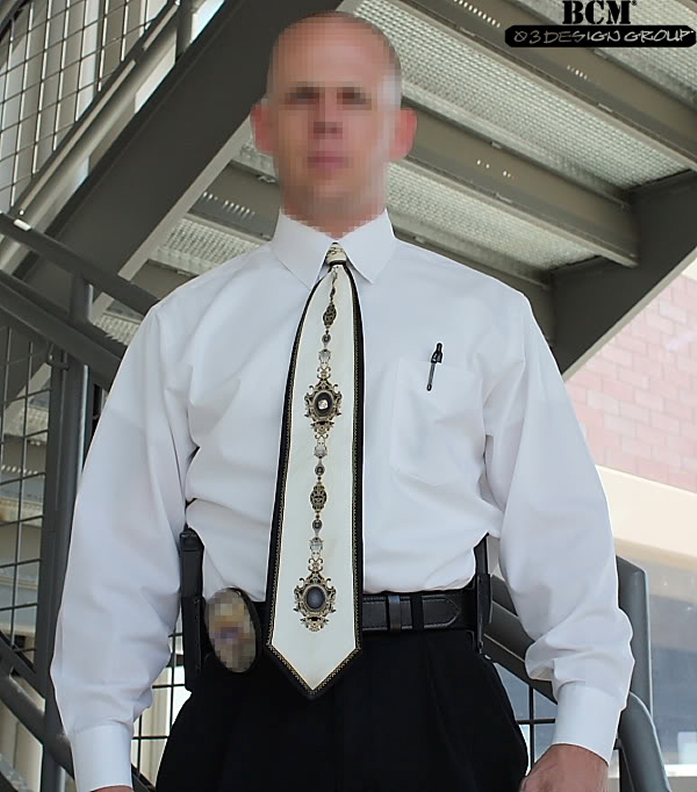
If a high priority call goes out, I grab my concealable body armor and throw it on over my shirt and tie:
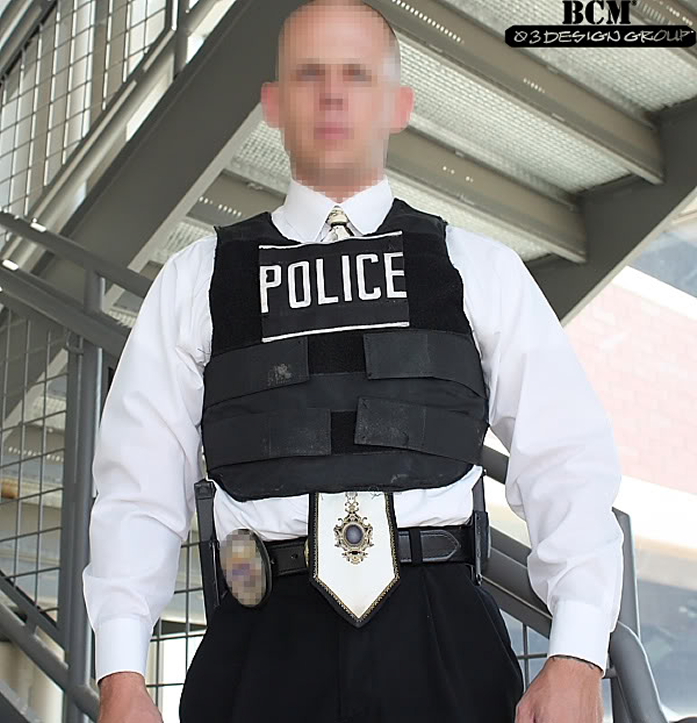
Then don the BCM 03 MSF Chest Harness on top of the concealable body armor. To don both the concealable body armor and BCM 03 MSF takes just a couple of seconds:
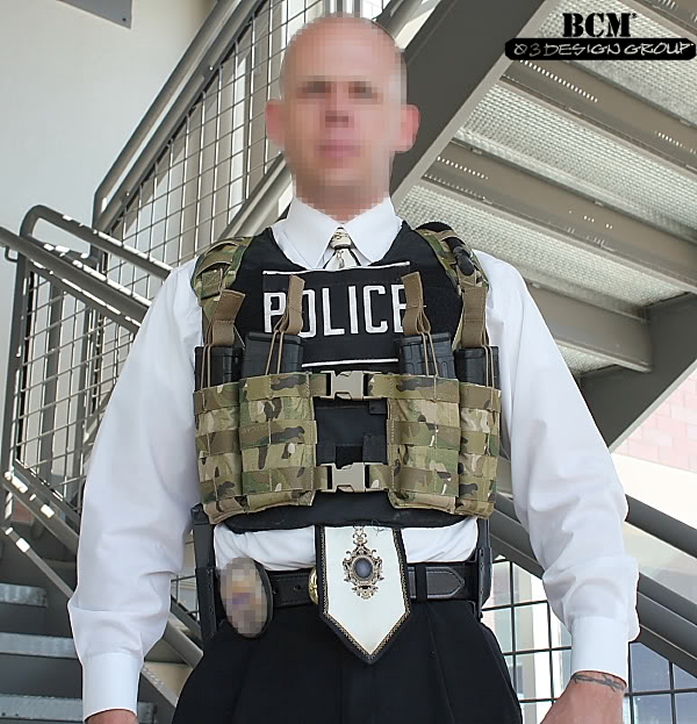
Pics of the right, left, and rear sides of the BCM 03 MSF Chest Harness. Note that the chest harness doesn't interfere with any of the gear that I'm wearing:
Right:
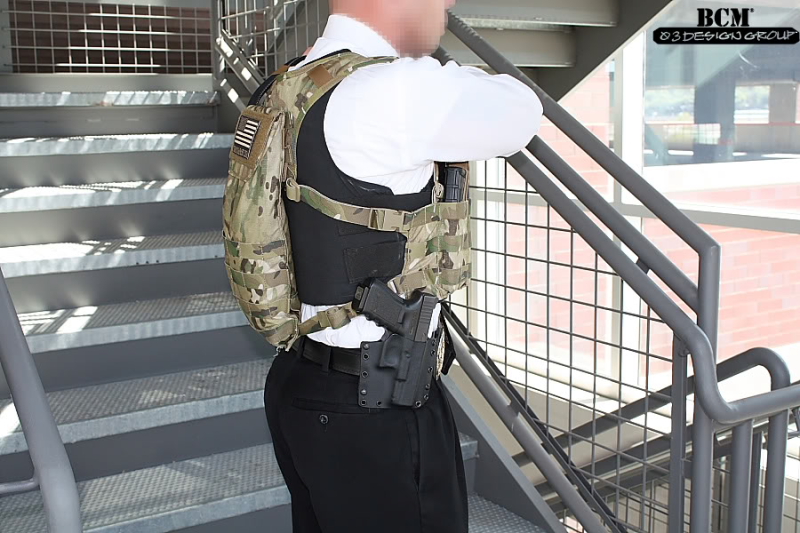
Left:
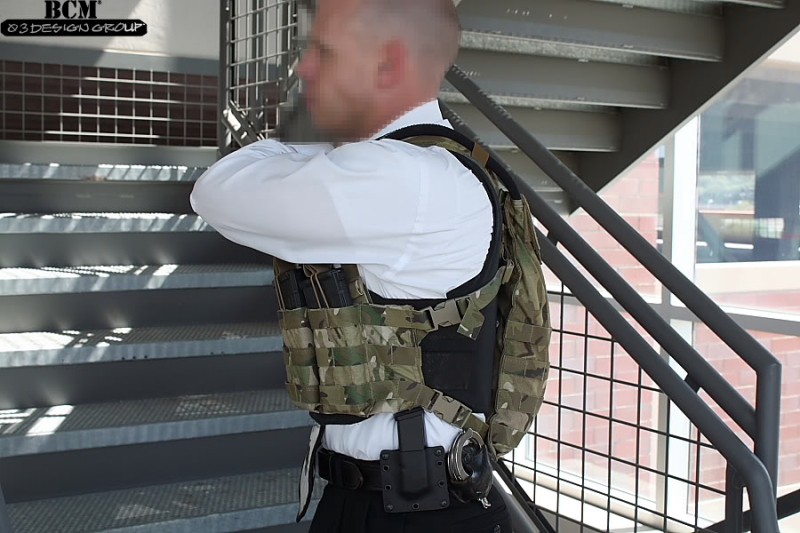
Rear (note the ID panel on the hydro carrier lid for identification patches):
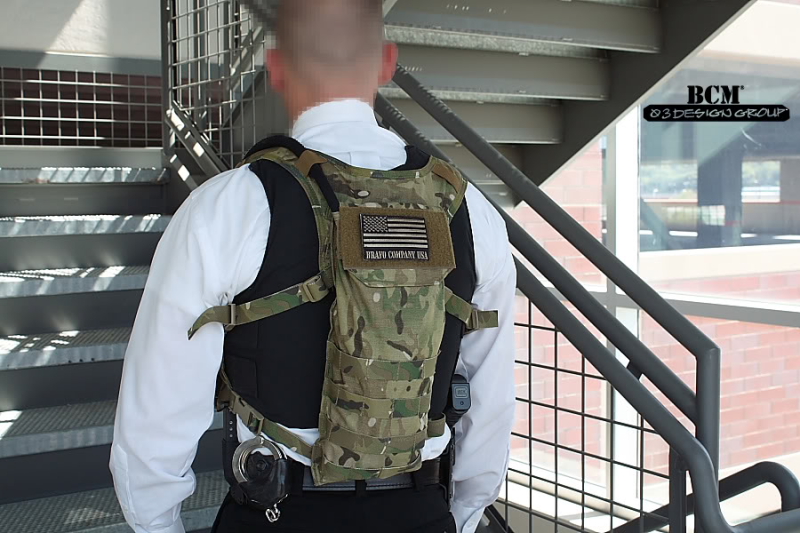
SWAT:
When I first got on SWAT in early 1999 it was common practice to wear a load bearing vest over your body armor. This was before armor carriers covered in MOLLE webbing were readily available.
I have found that there are times when I would like a light weight, low profile chest harness for some SWAT missions:
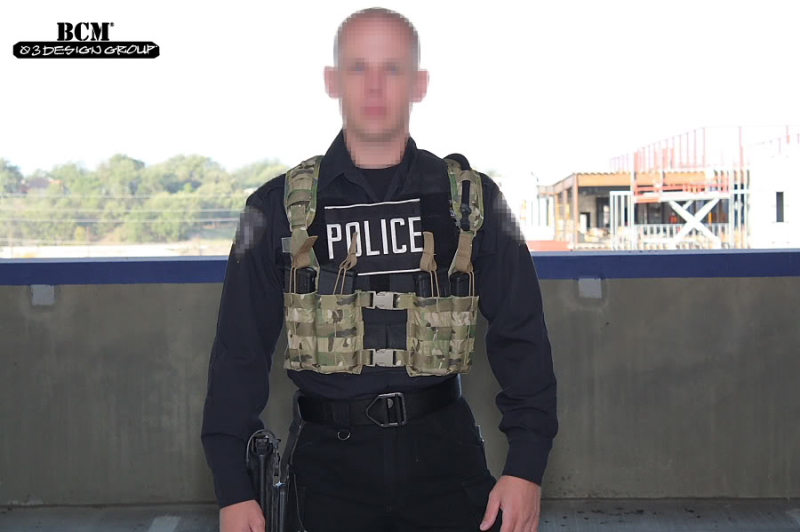
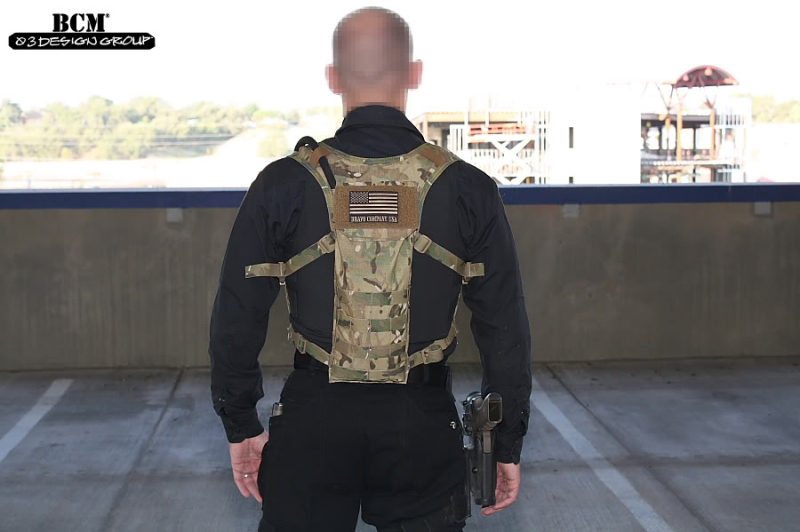
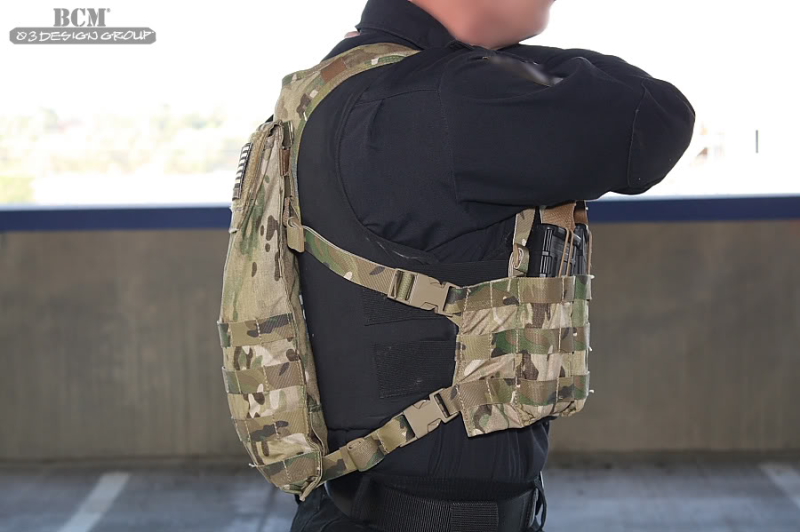
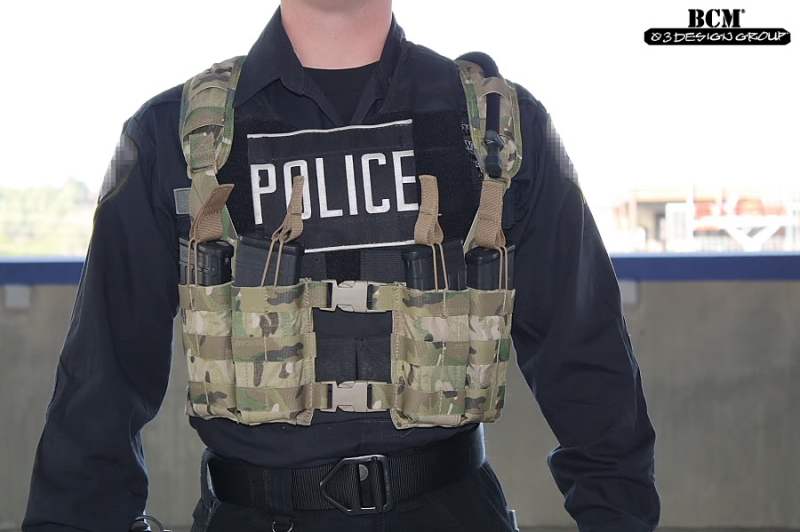
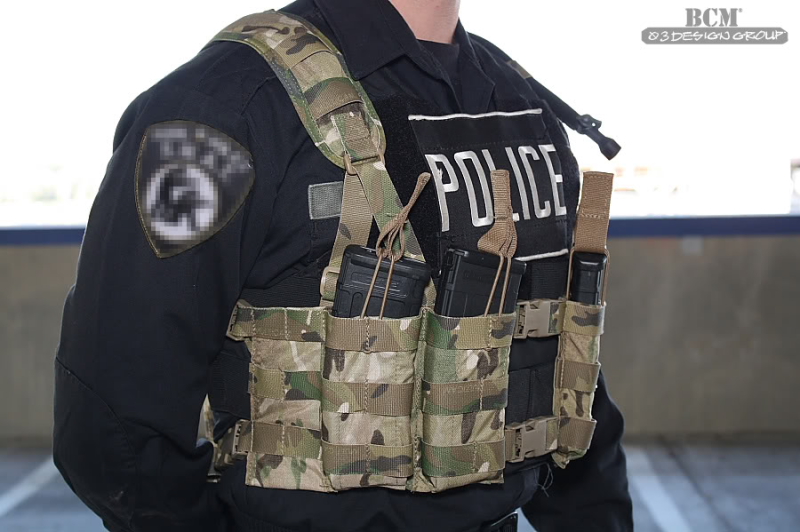
Undercover / Plain Clothes:
Buy / bust operations, VIP security details, and other missions there is a need to wear plain clothes and remain unnoticed while sitting in a parking lot or other location. These missions can be the most challenging in reference to gear selection. You need the ability to hide your gear and blend in with the rest of society, while maintaining the ability to deploy rapidly.
T-shirt with concealable body armor and the chest harness worn over the concealable body armor:
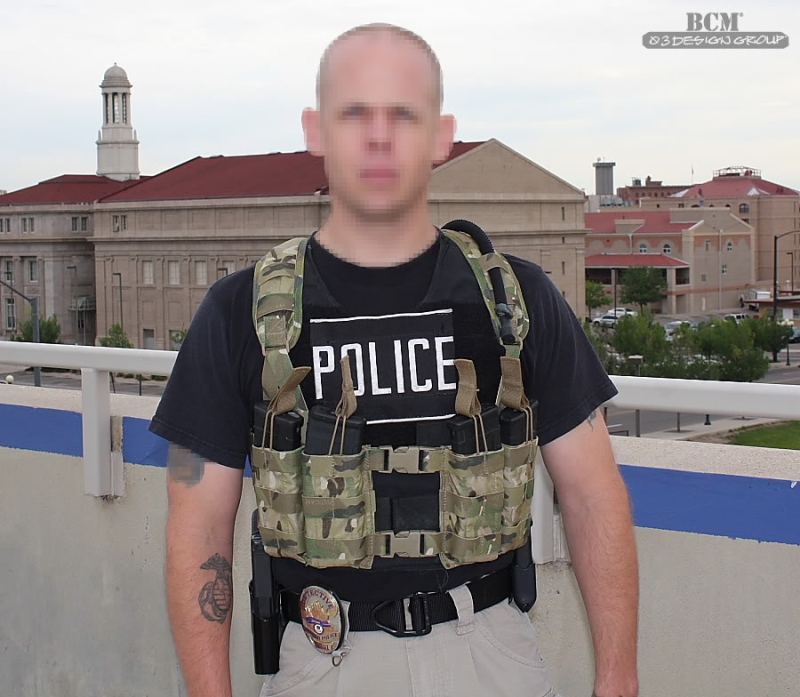
Wear a button down short sleeve shirt or light jacket (depending on season) over the concealable body armor and BCM 03 MSF:

Buttoning one or two buttons of the shirt conceals the armor / chest harness, but helps you shed the outer garment quickly when needed.

Uniformed Patrol:
Throw the chest harness in with the rifle bag in the trunk of a patrol cruiser. Anytime you need to deploy the carbine / rifle, you can don the chest harness. In an emergency, a Patrol Officer can throw the chest harness on over his shoulders, leaving the front open, grab his long gun, and go. The chest harness doesn't interfere with gear that most Patrol Officers wear:
BCM 03 MSF Chest Harness in the trunk with a gun bag:
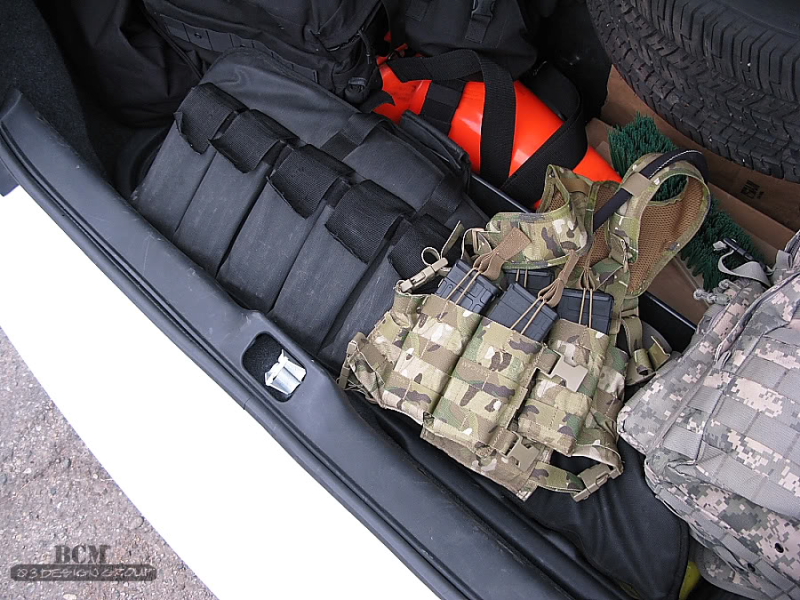
Front, rear, right, and left sides of the chest harness in a Patrol Uniform. The chest harness doesn't interfere with the draw stroke of the pistol, access to the radio, or other gear.
The two 1" straps on the front of the shoulder yoke can be used for routing communication wires, hydration tubes, or attaching a badge or shoulder mic:
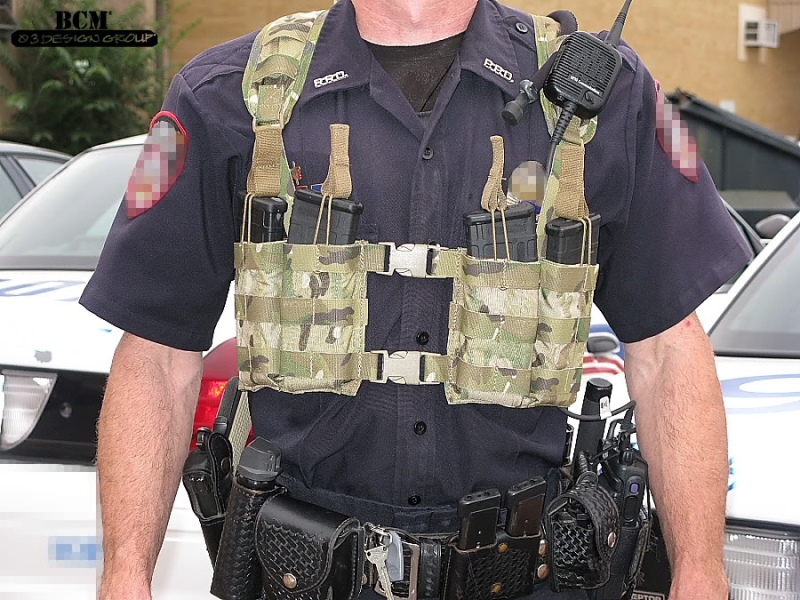
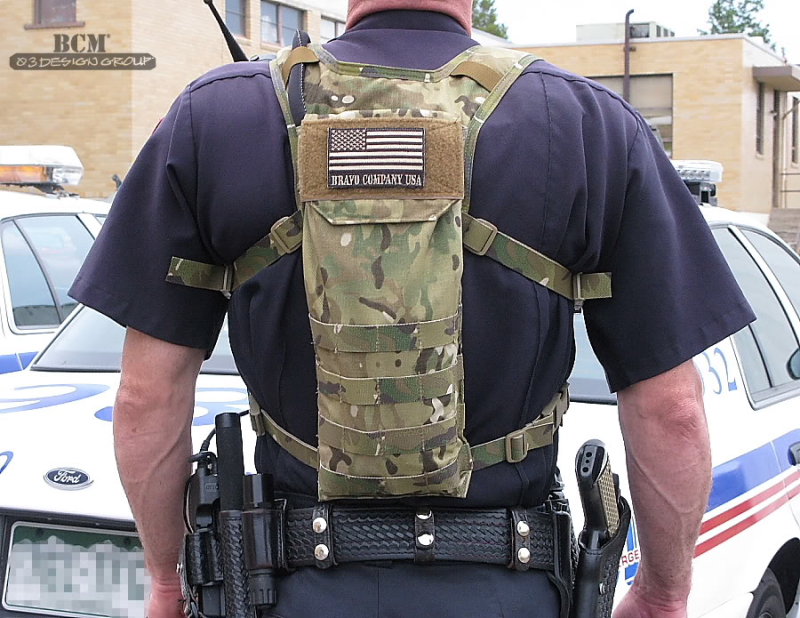
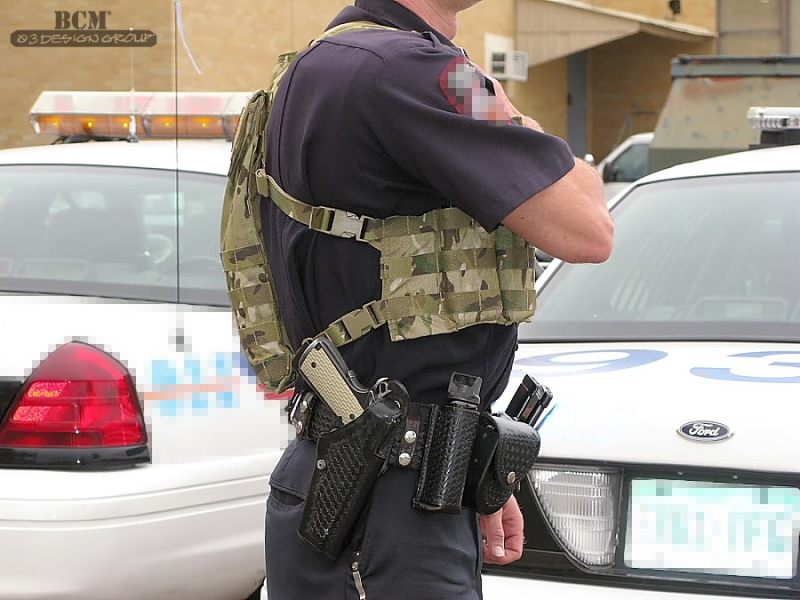
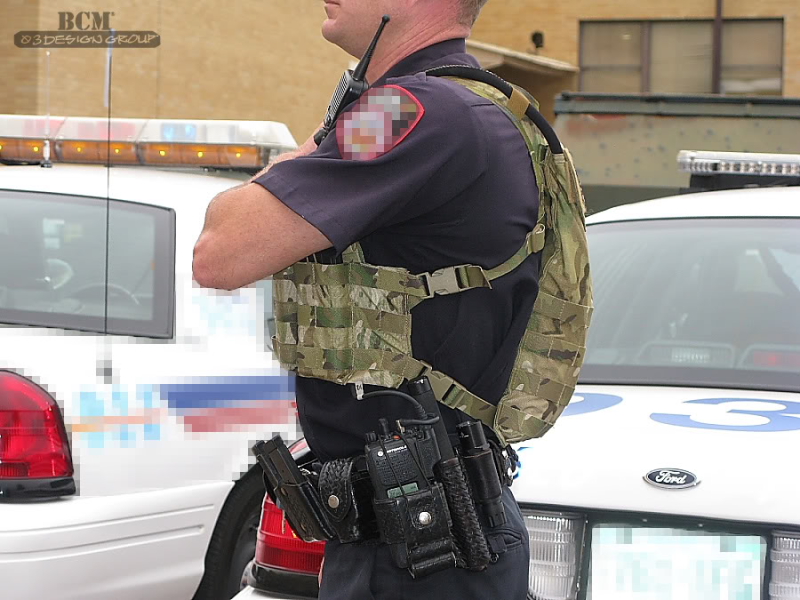
Training courses
In most carbine training courses the student will need 3 - 4 rifle magazines, a couple pistol magazines, water, and some students opt for a dump pouch. Often times I see students coming to class with a load out of 8 - 12 magazines, admin panels, large misc. pouches, etc. I see these same students fighting their gear the entire class. Most would be better served with lower profile gear.
MOLLE pistol magazine pouches, dump pouches, medical pouches, etc. can attached directly to the MOLLE webbing on the outside of the chest harness.
The hydration pouch provides a hydration system as well as helps balancing the weight on the front of the chest harness, thus making it more comfortable to wear over long periods of time.
The split front design allows students to get in and out of their gear quickly and easily on brakes (etc) . The chest harness can also be used in conjunction with most in the waist band or out of the waste band holsters and pistol magazine pouches. Thus a student can use his CCW gear with the BCM 03 MSF.
Bravo Company Manufacturing / 03 Design Group - BCM 03 MSF Chest Harness
Bravo Company Manufacturing - BCM 03 MSF Chest Harness (click the links at the bottom of the page for more pics) Currently offered in MultiCam, Coyote Brown, and Black.
